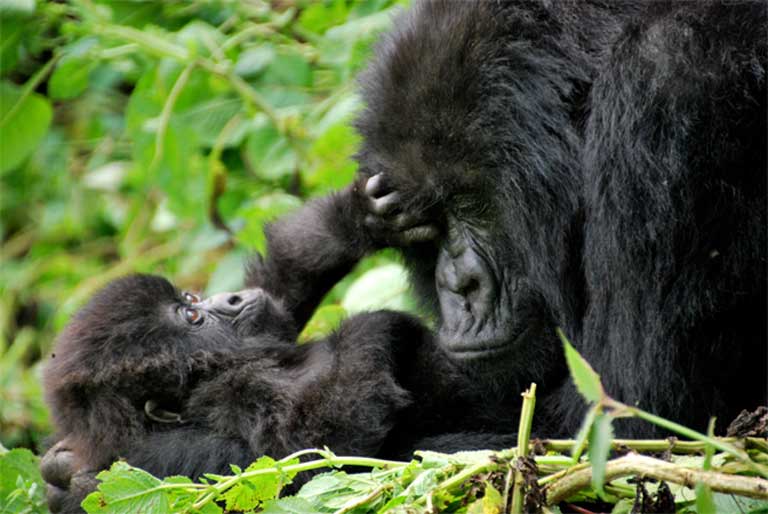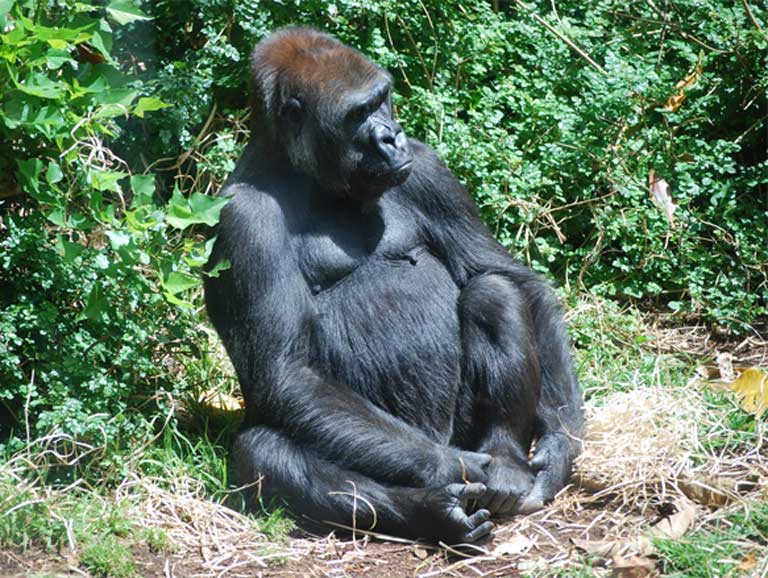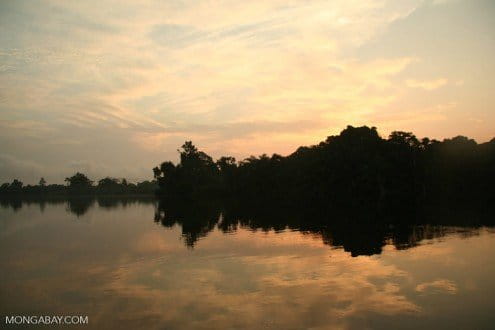- Since 2005 up to 227,000 square kilometers (87,645 square miles), an area nearly the size of Ghana, has been acquired in sub-Saharan Africa for large-scale agricultural and forestry concessions. And more concessions are on the way.
- With oil palm production poised to explode in Africa, conservationists are scrambling to set up standards for the industry, an effort complicated by by the extreme poverty and corrupt power elites found in many nations.
- If Africa’s priceless natural heritage is to be preserved, including its great apes, then a revolution in agricultural practices is needed which will demand a cooperative effort by governments, agribusiness and conservationists.

Africa is similar to other developing regions of the world in that agriculture is central to the continent’s economy, composing almost one quarter of its GNP and employing nearly two-thirds of its labor force.
Historically the loss of most wildlife habitat has been due to subsistence agriculture as a growing rural population met its dietary needs with small landholdings, and farmers cut trees, cleared brush and planted crops to directly support their families and livestock.
Lately though, the mixed blessings of globalization have dragged Africa into the uncertain world of industrialized agriculture, in which foreign corporations buy or rent enormous tracts of land for the cultivation of mono-crops, forming plantations of sorghum, cassava, peanuts and cocoa (sometimes harvested by enslaved children), with a new emphasis on oilseed crops for export, especially palm oil — all worked by African laborers and overseen by foreign investors.
As a result, the scale of land conversion — from either intact forest habitat, or small farms mixed with forest patches — into uniform rows of chemically treated crops destined for foreign export and consumption has skyrocketed. This transformation is driven by an insatiable hunger for palm oil and other commodities by booming Asian economies, as well as industrialized North America and Europe.
Africa, hamstringed by weak central governments; corrupt federal, regional and local officials; and a workforce eager to abandon traditional farming for the promise of higher wages, is at a crossroads. A new plantation-style agricultural economy, mirroring developments in Indonesia, is rapidly becoming the status quo in parts of Central and West Africa, regions also renowned for vast tracts of forests and the primal habitats of some of the world’s last great apes. And therein lies the problem.
What we stand to lose
Africa is home to three well-known and popular great apes: gorillas, chimpanzees, and bonobos. Of these, the gorillas are the most seriously threatened.
There are two species of gorilla in the world today, the Western gorilla (Gorilla gorilla) — composed of two subspecies, the Western Lowland (Gorilla gorilla gorilla) and the Cross River gorilla (Gorilla gorilla diehli) — and the Eastern gorilla (Gorilla beringei), with its own subspecies — the Mountain (Gorilla beringei beringei) and the Eastern Lowland gorilla (Gorilla beringei graueri).

The International Union for the Conservation of Nature (IUCN) Red List of imperiled plants and animals ranks Western gorillas as Critically Endangered, their populations reduced over 80 percent in just three generations over their range in Angola, Cameroon, Central African Republic, Congo, Equatorial Guinea, Gabon and Nigeria. Western gorillas are extinct in their former range in Democratic Republic of the Congo.
The biggest current threats to these animals are poaching — either for the bushmeat trade or wildlife trafficking — and the Ebola virus, which kills these great apes in horrific numbers. Poaching and Ebola have massively accelerated since the 1980s when roads were gauged deeply into primal forests to facilitate mechanized logging, mostly for export. Logging roads have fragmented or destroyed wide swaths of habitat and exposed gorillas to a variety of disturbances, including commercial hunting and/or live capture, disease outbreaks (sometimes due to exposure to human infectious diseases), and loss of habitat and forage that inevitably comes along with extraction industries.
The Ebola virus is thought to be harmlessly harbored by bats, but when primates are infected the contagion rages across species lines, infecting humans, gorillas, and chimpanzees with vigor. The IUCN reports that, “in three different outbreaks at two different study sites, individually known social groups containing almost 600 gorillas were monitored. In all three outbreaks about 95 percent of known individuals died” —cataclysmic statistics that far outstrip percentages of human deaths to the same disease.

The two Eastern gorilla subspecies — in Rwanda, Uganda, and the Democratic Republic of the Congo — are most threatened by the very dense rural human populations that surround their prime habitat. The IUCN enumerates threats including: “incursions by militia, habitat destruction for firewood and farmland, illegal cattle grazing, illegal timber extraction, and illegal hunting, including snares set for other mammals such as antelope that can injure or kill gorillas.” In 2004 alone, fifteen square kilometers (3,707 acres of gorilla habitat) was deforested for conversion to farmland, and recently there has been a sharp increase in timber extraction for the illegal production of charcoal. There has also been a resurgence of poaching for the illegal pet trade and bushmeat.
These are all instances of either direct take (poaching or capture) or habitat loss (conversion to commercial agriculture); in a region suffering some of the fastest-growing human populations in the world.
Subsistence agriculture meets global agribusiness
As with most preindustrial societies, Africa’s farmers traditionally worked small plots of around one hectare (slightly less than 2.5 acres). European colonization brought with it expansive farming techniques designed not to feed locals but enrich foreign investors through international trade — a political economic paradigm brutally realized in the Belgian Congo, and searingly portrayed in Joseph Conrad’s Heart of Darkness.
With the collapse of imperialism in the mid-twentieth century and the independence of African states, many foreign-owned plantations were centralized by the new governments or divvied up to local farmers and returned to small-scale cultivation.
Independence frequently brought with it a renewal of ethnic and religious antagonisms that had been suppressed by colonialism. Sporadic civil wars, lack of infrastructure and persistent governmental corruption all played a role in hampering the adoption of sustainable, scientifically managed agriculture in most of Africa.

Those problems and agricultural patterns persist today, with crop yields and advances in farming techniques remaining stagnant, even as more land is converted to large-scale plantations. Thus forests — and the last redoubts of great ape habitat — are under attack from two sides: by antiquated slash-and-burn farming techniques and by global agribusiness, while no great benefits are accruing to the rural poor whose future depends upon the wise use of limited resources.
An interdisciplinary study by Cambridge University and the Arcus Foundation, State of the Apes 2015: Industrial Agriculture and Ape Conservation, notes with alarm that “a recent analysis found that up to 227,000 square kilometers [87,645 square miles], an area nearly the size of Ghana, has been acquired across sub-Saharan Africa since 2005 [for agricultural and forestry concessions]. Large-scale agricultural projects comprise approximately 85 percent of this land area, while plantation forestry accounts for the remainder.”
This represents a breathtakingly huge transference of property rights from native smallholders to global agribusiness, and with it comes the imposition of outside consumer demands that dictate the way African land is being used. The report found that “Oilseed crops, including castor, oil palm, sesame and sunflower, have piqued the most commercial interest, accounting for more than 60 percent of all land area acquired on the African continent since 2005.”
Meanwhile, “agribusiness investment in traditional African cash crops such as cocoa, coffee, tea, tobacco and cotton has been relatively low.” The data clearly show that colonialism by another name — call it market capitalism — is likely to be far worse for great ape habitat than the slow growth of subsistence farming over the centuries.
In a Mongabay interview, Maria Belenky, one of the lead scientists of the State of the Apes report, and a Senior Associate with Climate Advisors, painted a stark picture of Africa’s remaining ape habitat, which is on the brink of some profound changes. She underlined the absolute necessity of getting out ahead of industrial agriculture development in Africa by creating sensible guidelines and sustainable standards before the arrival of the plantation-clearing chainsaws — something that is happening to some degree in West African countries such as Cameroon and Gabon.

“I think the primary threats to ape habitat in most parts of Africa remain the expansion of smallholder farming and industrial/artisanal timber harvesting,” she said. “Wildmeat hunting is also a factor, one that is exacerbated when commercial logging operations facilitate human access to ape habitat. Industrial-scale agriculture has not yet expanded at the pace and scale as we’ve seen elsewhere in the world — think parts of Latin America or Southeast Asia. That said, vast areas of land have been acquired for large agro operations in Africa, they just haven’t yet been developed, for a variety of reasons. Whether these plans are carried out responsibly both from environmental and social standpoints will be important for us to watch.”
Time is of the essence, and conservation groups in Africa are scrambling to work out sustainable standards with agro industry. China’s currently sagging economy has resulted in a global slowdown of resource extraction for the moment — including Indochina and African palm oil production — which is offering a window of opportunity for those hoping to gain meaningful protections for critical ape habitat.
A continent strapped by big problems
Simultaneously protecting great ape habitat, while setting conservation standards in anticipation of a global agro industry boom, is made significantly more difficult by the intractable problems of modern Africa.
The implementation of cutting edge conservation techniques and innovative land use policies is made exponentially difficult in Africa by an exploding population, mostly poor; widespread bureaucratic corruption; and autocratic centralized decision making that is lacking in local public participation. Add to that an approach to land management that allows international companies, urban elites and federal governments to blindly agree to sweeping agro business concessions on vast stretches of forest lands with little regard for the needs of local communities or great ape habitat.

“Better land planning is a must,” Belenky told Mongabay. “Good mapping exists for a number of areas, but not all. If a government wants to promote economic development in part through large-scale agriculture, it must work with the concessionary to smartly determine the area that is best suited for growth while causing the least amount of harm — both environmentally and socially.”
Poor farming practices have long been a major driver of habitat loss throughout Africa, practices that include rampant uncontrolled deforestation, the continual loss of topsoil through erosion, with resultant siltation and chemical contamination of waterways, and the rapid depletion of soil fertility; leading to further deforestation and conversion to croplands elsewhere.
The good news: exhausted or marginal farmland; bypassed, left fallow and returned to woodlands; can often be resuscitated through modern agronomic techniques. Which means that some of these lands, with careful evaluation and management, might serve well as sites for new oil palm concessions — rather than cutting native forests. However, other exhausted agricultural lands taken over by second growth forest and reclaimed by great apes are better off being protected, not converted to plantations. That’s why careful assessment by trained conservation scientists is so important. And all these choices need to take into consideration the economic needs of local communities.
But if this sort of informed and involved approach to land use management is to come to fruition, it will demand the full commitment of Africa’s governments, agribusiness, and conservationists working together on a relatively level playing field. That necessitates an end to the lucrative backroom deals made exclusively for profit by well-connected African politicians and businessmen with foreign conglomerates — a tall order.

International aid and lending programs need to offer technical assistance to achieve sustainable large-scale agriculture, environmental conservation, and the socio-political structures that can help bring them about. This can’t be done in the old colonial way of managing from abroad or above, but requires a local scientific approach that seeks to fully understand the particular needs and ownership patterns — both legal and traditional — of the immense rural landscapes that surround Africa’s booming cities.
“Where are these tracts of land located?” asks Maria Belenky. “Are there any conflicting claims to that land? For industrial agriculture to develop responsibly and sustainably, there needs to be detailed land-use mapping and, more importantly, a plan of action to use this information to protect areas of ecological and human importance.”
Simply put, an agricultural revolution is needed in Africa. And that revolution will require a serious, rapid commitment by the international business and conservation communities, in league with African governments.
Such an alliance would need to balance and serve the requirements of agribusiness investors with the continent’s rural people and wildlife. Developed and developing world partners would also need to learn to see the vast forests of Africa as an irreplaceable non-renewable resource and its wildlife as a priceless legacy worth preserving for the African people and the people of the planet.
Without concerted action, the world is on track to forever lose those verdant forests, the birthplace of humanity as well as our primate kin. The world’s gorillas — teetering on the knife-edge of extinction — are at stake.

